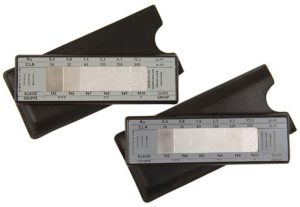Home » Products » Coating Inspection » Surface Preparation » Roughness – Machined Ra » Elcometer 129 Rubert & Rugotest Surface Comparators
Elcometer 129 Rubert & Rugotest Surface Comparators

Product Description
The Elcometer 129 Surface Comparators are available in two models:
• Elcometer 129 Rubert – available in grit and shot versions
• Elcometer 129 Rugotest – shot and grit profiles on the same block
Roughness is displayed in both “classes” and “roughness averages” for easier identification. Available in Metric only.
6 Roughness Values per Comparator.
Test Method – ASTM D4417 Method A
In Summary, this test method requires that the appropriate comparator is selected and compared with the surface by sight – with or without magnification, or touch.
The closest match to the actual surface indicates the surface roughness.
Comparisons should be made at an agreed series of locations, which characterize the surface.
The Elcometer 129 can be used in accordance with:
• AS 3894.5
Specifications
Elcometer 129 Rubert & Rugotest Surface Comparators – Specifications
| Part Number | Description | Section Profiles |
| E129—1 | Elcometer 129/1 Rubert Grit Surface Comparator | 0.4, 0.8, 1.6, 3.2, 6.3, and 12.5µm |
| E129—2 | Elcometer 129/2 Rubert Shot Surface Comparator | 0.4, 0.8, 1.6, 3.2, 6.3, and 12.5µm |
| E129—3 | Elcometer 129/3 Rugotest Shot & Grit Surface Comparator | N6, N7, N8, N9, N10 and N11 equivalent to 0.8, 1.6, 3.2, 6.3, 12.5, and 25µm roughness averages respectively |
Packing List
- Elcometer 129 Rubert and Rugotest Surface Comparators
Data Sheet
Elcometer 129 Rubert & Rugotest Surface Comparators – Data Sheet
Elcometer 129 Rubert & Rugotest Surface Comparators Data Sheet
Standards
Elcometer 129 Rubert & Rugotest Surface Comparators – Standards
The Elcometer 129 can be used in accordance with:
• AS 3894.5
Video
Elcometer 129 Rubert & Rugotest Surface Comparators – Video
Surface Comparators are used to quickly assess the surface profile of a blasted metal surface.
Surface Comparators are a flat, steel plate which contain a number of reference surface profiles, formed on a corrosion resistant metal.
These reference profiles are then compared to the freshly blasted surface – many comparators have a hole in the middle to make this comparison easier – and a profile grade is then defined by the inspector.
Due to the speed of the test, this method is especially useful when you want to go from blasting to painting as quickly as possible to avoid flash rust, or when measuring in hazardous areas where electronic equipment is prohibited.
Elcometer has a range of surface comparators for use with different standards and for different profile finishes.
With all loose dust and debris removed from the test surface, place the appropriate surface comparator against it, and compare, in turn, the test surface with each segment of the comparator.
This can be done with the assistance of a magnifier if necessary. We recommend a x5 magnifier, as it allows you to easily compare the surface with a single segment of the comparator in great detail.
If visual assessment proves difficult, it is possible to do a tactile assessment – in other words, touch.
Once you’ve assessed the profile against each segment of the comparator, you determine the grade. This is not a case of simply choosing which segment the profile is closest to – it is defined as follows:
If the profile is smoother than segment 1, the finest grade on the comparator, it is Finer-than-Fine.
If the profile is equal to segment 1 and up to, but excluding segment 2, it is Fine.
If the profile is equal to segment 2 and up to, but excluding segment 3, it is Medium.
If the profile is equal to segment 3 and up to, but excluding segment 4, it is Coarse.
And finally, if any profile is assessed as being rougher than segment 4, it is Coarser-than-Coarse.
Simply record your result, and then test another area of the surface.

